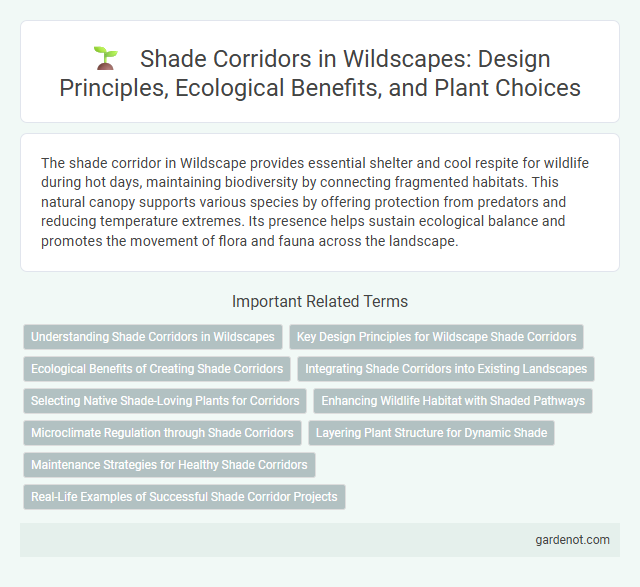The shade corridor in Wildscape provides essential shelter and cool respite for wildlife during hot days, maintaining biodiversity by connecting fragmented habitats. This natural canopy supports various species by offering protection from predators and reducing temperature extremes. Its presence helps sustain ecological balance and promotes the movement of flora and fauna across the landscape.
Understanding Shade Corridors in Wildscapes
Shade corridors in wildscapes create essential microhabitats by providing cooler, sheltered pathways for wildlife movement and plant growth. These shaded areas help maintain biodiversity by offering thermal refuge and reducing exposure to predators and extreme weather. Understanding shade corridors supports conservation efforts aimed at enhancing ecosystem connectivity and resilience in natural landscapes.
Key Design Principles for Wildscape Shade Corridors
Shade corridors in wildscape design prioritize native vegetation layers to enhance biodiversity and provide habitat connectivity for shade-adapted wildlife species. Incorporating structural complexity through varied canopy heights and understorey plants supports microclimate regulation and promotes ecological resilience. Strategic placement along natural pathways ensures seamless movement of fauna while optimizing shade provision and soil moisture retention.
Ecological Benefits of Creating Shade Corridors
Shade corridors enhance biodiversity by providing cooler microhabitats essential for temperature-sensitive species, supporting the survival of amphibians, insects, and understory plants. These shaded pathways contribute to soil conservation by reducing evaporation rates and preventing erosion through stabilized root systems. Furthermore, shade corridors improve air quality by filtering pollutants and increasing oxygen levels, creating healthier environments for both wildlife and humans.
Integrating Shade Corridors into Existing Landscapes
Integrating shade corridors into existing landscapes enhances biodiversity by providing continuous habitat for shade-loving species and improving microclimate conditions. Strategic planting of native tree species along pathways, riparian zones, and urban green spaces creates interconnected networks that support wildlife movement and reduce heat island effects. Incorporating shade corridors with ecological planning promotes sustainable urban development and resilience against climate change impacts.
Selecting Native Shade-Loving Plants for Corridors
Selecting native shade-loving plants for wildscape shade corridors enhances biodiversity by supporting local wildlife and maintaining ecological balance. Species such as ferns, wild ginger, and native azaleas thrive in low-light conditions and improve soil stability while providing essential habitat. Incorporating these plants optimizes corridor functionality by ensuring plant resilience and promoting native pollinator activity.
Enhancing Wildlife Habitat with Shaded Pathways
Shade corridors provide essential shelter and cooler temperatures, creating ideal microhabitats for diverse wildlife species within wildscapes. These shaded pathways support increased biodiversity by offering protection from predators and harsh weather, promoting movement and foraging opportunities. Integrating native trees and dense vegetation along these corridors enriches habitat connectivity and ecological resilience.
Microclimate Regulation through Shade Corridors
Shade corridors in wildscapes create cooler microclimates by reducing direct solar radiation, which helps moderate temperature extremes and conserve soil moisture. These shaded pathways support biodiversity by providing refuge for temperature-sensitive species and enhancing habitat connectivity. Effective microclimate regulation through shade corridors mitigates heat stress and promotes ecosystem resilience against climate variability.
Layering Plant Structure for Dynamic Shade
The Shade Corridor in Wildscape features a meticulously layered plant structure designed to create dynamic shade patterns that respond to seasonal changes and sunlight angles. This multi-tiered vegetation includes tall canopy trees, mid-level shrubs, and low ground cover plants, maximizing shade density and biodiversity. Such stratification not only enhances microclimate regulation but also supports diverse wildlife by providing varied habitats within the corridor.
Maintenance Strategies for Healthy Shade Corridors
Regular pruning and removal of invasive species are essential maintenance strategies to ensure healthy shade corridors within wildscapes. Implementing soil health monitoring and mulching techniques promotes root vitality and moisture retention, supporting mature canopy growth. Scheduled inspections for pest and disease management help maintain structural integrity and biodiversity in these shaded habitats.
Real-Life Examples of Successful Shade Corridor Projects
The High Line in New York City exemplifies a successful shade corridor project, transforming an elevated rail line into a lush urban greenway lined with diverse tree species that provide ample shade and enhance biodiversity. Similarly, Singapore's Park Connector Network integrates shaded pathways with dense foliage, encouraging pedestrian and cyclist use while mitigating urban heat island effects. Melbourne's Green Spine project incorporates extensive canopy coverage along major streets, creating continuous shaded corridors that improve walkability and urban comfort.
Shade corridor Infographic

 gardenot.com
gardenot.com